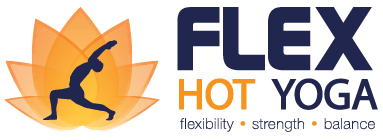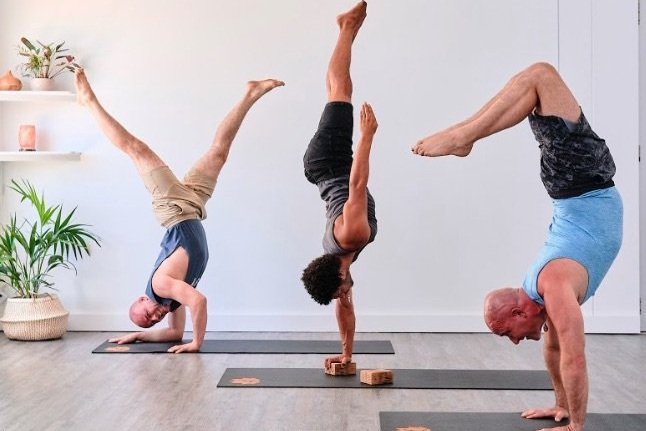Posture of the month: Adho Mukha Vrksasana (Handstand)
Ready for lift off in 2022?!
It’s January again, so like every year, we will practice Adho Mukha Vrksasana - the Handstand. As we begin a new cycle around the sun, it’s important to remember that challenging ourselves is what keeps things fresh. So join us this month and take flight!
In Sanskrit, Adho Mukha Vrksasana means 'Downward Facing Tree' (from adho: downward, mukha: face, vrksa: tree and asana: posture), because in its basic form, it is the exact inversion of the regular tree posture.
Adho Mukha Vrksasana stimulates the Sahasrara chakra (crown) by channeling root energy from the Muladhara chakra (bottom of the spine) to the head. Let’s explore what that means…
Benefits of practicing Adho Mukha Vrksasana
In order to safely practice handstands, your need a certain amount of strength, body and breath awareness and flexibility, all of which we will practice in class this month. When it all finally comes together and you go upside down, these are the benefits you will reap:
(1) Improves strength and flexibility
Practicing Adho Mukha Vrksasana requires the combined effort of several muscle groups: core (transverse and rectus abdominis, internal and external obliques), upper body (trapezius, triceps, deltoids), pelvic floor (psoas and adductors), and joints like hip flexors, shoulders and wrists. The more you practice, the more natural it will feel for them to work together, and the more strength and flexibility you will be able to create.
(2) Stimulates adrenal glands and cardiovascular system
At the beginners level, handstands require you to jump onto your hands, which - the more you do it - increases the flow of energy in your body. This energy creates an adrenal rush that increases the blood flow to your brain and muscles. Your heartbeat increases, keeping the cardiovascular activity stimulated.
(3) Focus and Balance
Keeping your shoulders and wrists aligned requires focus and attention. So does not flipping over backwards and holding yourself steady. Also, when upside down, your brain may initially get disoriented both by the change in orientation and the sudden blood rush to the head. All these experiences require you to be 100% present and in the moment - a great way to train your single-pointed focus whilst improving your balance, too.
(4) Energy and Breath
When in handstand, your abdominal organs press into your diaphragm, expanding it. This allows for the lungs to expand, which allows you to inhale and exhale much more deeply. This increases the prana (life force energy) in your body and will at the same time improve your breath awareness.
(5) Spine and Bone
Practicing handstands relieves pressure on your joints and feet and will - over time - help lengthen your spine. This, in turn, can help reverse spinal degeneration due to compression, e.g. if you are sitting on a desk all day long. This same anti-gravity effect helps release the buildup of lactic acid in your muscles, especially in the lower half of your body.
(6) Releases Stress
Flipping your world upside down in handstand brings a rush of blood and oxygen to the brain. This activates your parasympathetic nervous system which has a calming effect by reducing cortisol in your blood stream and therefore alleviating symptoms of mild depression and anxiety.
(7) Confidence and a fresh perspective
Mastering a challenging posture like Adho Mukha Vrksasana builds confidence and will increase your ability to attune more clearly to your body and mind. It may also give you a new perspective on life: after all, you are activating your crown chakra (sahasrara) whilst - on a physical level - the reversed blood flow energises your mind. Both will help expand your view and may allow you to connect the dots in new and unexpected ways!
Activating your Crown Chakra (Sahasrara)
Sahasrara is the 7th chakra and is located just above the crown of the head. It is mainly associated to the pituitary gland, and secondarily to the pineal gland and hypothalamus, both of which regulate the endocrine system. It governs your brain, your nervous system and your intuition.
The crown chakra is usually depicted in white or deep purple. Linked to the Divine and the infinite, it represents universal awareness and your ability to transcend limitations both on a personal level and beyond.
The crown can be a challenging energy center to connect with
The main method recommended to activate the crown is meditation. However, when practicing handstands, you are sending energy from your root chakra to the crown, which increases mental clarity and awareness and can help you access higher states of consciousness.
When balanced, you are open-minded and feel a deep sense of oneness with all that is around you, and a natural connection to the Divine. Sahasrara represents enlightenment and reaching a pure awareness state, letting go of attachments and ego.
When out of balance in this chakra, we feel disconnected and in our head. This can be experienced through depression, losing our sense of joy and feeling stuck. Or - on the other side of the spectrum - by a sense of superiority or cynicism, closed-mindedness, elevating ourselves above others, thinking we are ‘better than’ and holding an arrogant and judgmental outlook on life.
So are you ready to take flight in 2022? Then come along to Flex regularly and practice with us! There are over 25 classes/week, and we will practice Adho Mukha Vrksasana daily during all of January 2022!
Our gratitude for their insights this month goes to Tummee.com for its excellent in-depth insights on yoga poses. And to author Lizzy on Chakra.info for her insights on the crown chakra.






